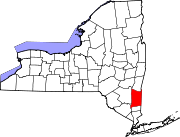
Dutchess County is a county in the U.S. state of New York. As of the 2020 census, the population was 295,911. The county seat is the city of Poughkeepsie. The county was created in 1683, one of New York's first twelve counties, and later organized in 1713. It is located in the Mid-Hudson Region of the Hudson Valley, north of New York City.
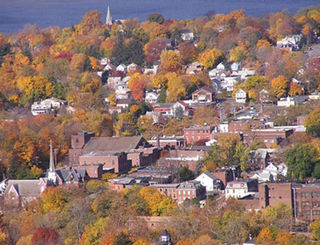
Beacon is a city located on the Hudson River in Dutchess County, New York, United States. As of the 2020 census, the city's population was 13,769. Beacon is part of the Kiryas Joel–Poughkeepsie–Newburgh Metropolitan Statistical Area as well as the larger New York–Newark–Bridgeport, New York–New Jersey–Connecticut–Pennsylvania Combined Statistical Area.

Beekman is a town in Dutchess County, New York, United States. It is part of the Poughkeepsie–Newburgh–Middletown, NY Metropolitan Statistical Area as well as the larger New York–Newark–Bridgeport, NY-NJ-CT-PA Combined Statistical Area. The population was 14,172 at the 2020 census. The town was named after Henry Beekman, a 17th-century land owner.
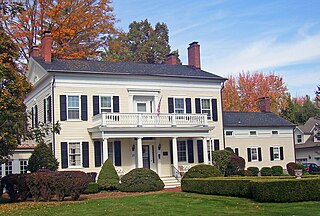
East Fishkill is a town on the southern border of Dutchess County, New York, United States. The population was 29,707 at the 2020 census. Until its creation in 1849, the town was the eastern portion of the town of Fishkill.

Wappinger is a town in Dutchess County, New York, United States. The town is located in the Hudson River Valley region, on the eastern bank of the Hudson River. The population was 28,216 at the 2020 census. The name is derived from the Wappinger Native Americans who inhabited the area. Wappinger comprises three-fourths of the incorporated village of Wappingers Falls, several unincorporated hamlets such as Chelsea, Diddell, Hughsonville, Middlebush, Myers Corners, New Hackensack, and Swartwoutville, and a number of neighborhoods.

Wappingers Falls is a village in the towns of Poughkeepsie and Wappinger, in Dutchess County, New York, United States. As of the 2010 census it had a population of 5,522. The community was named for the cascade in Wappinger Creek. The Wappingers Falls post office covers areas in the towns of Wappinger, Poughkeepsie, Fishkill, East Fishkill, and LaGrange. This can result in some confusion when residents of the outlying towns, who do not live in the village, give their address as "Wappingers Falls".

Cold Spring is a village in the town of Philipstown in Putnam County, New York, United States. The population was 1,986 at the 2020 census. It borders the smaller village of Nelsonville and the hamlets of Garrison and North Highlands. The central area of the village is on the National Register of Historic Places as the Cold Spring Historic District due to its many well-preserved 19th-century buildings, constructed to accommodate workers at the nearby West Point Foundry. The town is the birthplace of General Gouverneur K. Warren, who was an important figure in the Union Army during the Civil War. The village, located in the Hudson Highlands, sits at the deepest point of the Hudson River, directly across from West Point. Cold Spring serves as a weekend getaway for many residents of New York City.

Fishkill is a village within the town of Fishkill in Dutchess County, New York, United States. The village is in the eastern part of the town of Fishkill on U.S. Route 9. It is north of Interstate 84. NY 52 is the main street. It is part of the Poughkeepsie–Newburgh–Middletown, NY Metropolitan Statistical Area as well as the larger New York–Newark–Bridgeport, NY-NJ-CT-PA Combined Statistical Area. The first U. S. Post Office in New York state was established in Fishkill by Samuel Loudon, its first Postmaster.

Fishkill is a town in the southwestern part of Dutchess County, New York, United States. It lies approximately 60 miles (97 km) north of New York City. The population was 24,226 at the 2010 census. Fishkill surrounds the city of Beacon, and contains a village, which is also named Fishkill.

Poughkeepsie, officially the Town of Poughkeepsie, is a town in Dutchess County, New York, United States. As of the 2020 United States Census, the population was 45,471. The name is derived from the native term Uppuqui meaning "lodge-covered", plus ipis meaning "little water", plus ing meaning "place", all of which translates to "the reed-covered lodge by the little water place", or Uppuqui-ipis-ing. This later evolved into Apokeepsing, then into Poughkeepsing, and finally Poughkeepsie.
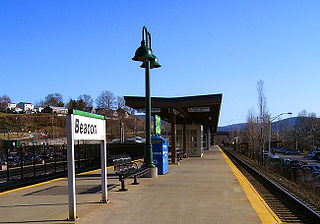
Beacon station is a commuter rail station on the Metro-North Railroad Hudson Line located in Beacon, New York. The station has three tracks, with one island platform and one side platform.
New Hamburg is a small hamlet along the Hudson River in Dutchess County, New York, United States. It is located in the southern corner of the town of Poughkeepsie.

New York State Route 376 (NY 376) is a state highway located entirely within Dutchess County in the Hudson Valley region of New York in the United States. The route begins at an intersection with NY 52 in East Fishkill and passes north through Hopewell Junction and Red Oaks Mill on its way to the city of Poughkeepsie. It ends at a junction with U.S. Route 44 (US 44) and NY 55 east of the city limits in Arlington, a hamlet in the town of Poughkeepsie. NY 376 was originally designated as part of NY 39 in the mid-1920s. In the 1930 renumbering of state highways in New York, the East Fishkill–Poughkeepsie portion of NY 39 was renumbered to New York State Route 202. NY 202 was renumbered to NY 376 in 1935 to avoid numerical duplication with the new US 202.

Fishkill Creek is a tributary of the Hudson River in Dutchess County, New York, United States. At 33.5 miles (53.9 km) it is the second longest stream in the county, after Wappinger Creek. It rises in the town of Union Vale and flows generally southwest to a small estuary on the Hudson just south of Beacon. Part of its 193-square-mile (500 km2) watershed is in Putnam County to the south. Sprout Creek, the county's third-longest creek, is its most significant tributary. Whaley and Sylvan lakes and Beacon Reservoir, its largest, deepest and highest lakes, are among the bodies of water within the watershed.

The Wappingers Falls Historic District is in the center of that village in Dutchess County, New York, United States. It is a 90-acre area roughly centered along South Avenue and West Main Street, NY 9D and Wappinger Creek. It includes Mesier Park in the center of the village and many adjacent residential neighborhoods, roughly bounded by Elm, Park, Walker, Market and McKinley streets.
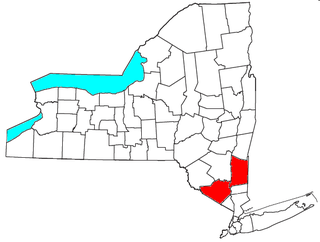
The Kiryas Joel-Poughkeepsie-Newburgh, NY Metropolitan Statistical Area, as defined by the United States Office of Management and Budget, is an area consisting of two counties in New York's Hudson Valley, with the municipalities of Kiryas Joel, Poughkeepsie, and Newburgh as its principal cities. As of the 2020 census, the MSA had a population of 679,221. The area was centered on the urban area of Poughkeepsie-Newburgh. Prior to July 2023, it was known as the Poughkeepsie-Newburgh-Middletown, NY Metropolitan Statistical Area; whereupon it was renamed to its current name, to reflect population changes among its largest municipalities.

The Cornelius Carman House is located along River Road South in Chelsea, New York, United States. It is a wooden house built in the 1830s, overlooking the Hudson River, for Carman, operator of a local shipyard and inventor of a moveable centerboard.
Wheeler Hill Historic District is a federally recognized historic district located at Wappinger in Dutchess County, New York. Along the eastern shore of the Hudson River, atop of the Van Wyck Ridge is the "estates region of the Town of Wappinger". A scenic location, with roads lined with stone walls, properties greeting guests with magnificent stone pillars and iron gates, it includes 49 contributing buildings, 15 contributing sites, and four contributing structures. It encompasses the estates of Obercreek, Elmhurst, Edge Hill, Henry Suydam, William Crosby, and Carnwath that were developed between 1740 and 1940. Also included are two 18th century riverfront commercial structures, the Lent / Waldron Store and Stone House at Farmer's Landing. It was added to the National Register of Historic Places in 1991. Today the historic district is mostly made up of residential houses, but Carnwath and Obercreek are opened to the public.
The Church of St. Joachim and St. John the Evangelist is a Roman Catholic parish church under the authority of the Roman Catholic Archdiocese of New York, located in Beacon, Dutchess County, New York. It was established after a parish mergers of the Church of St. Joachim, and St. John the Evangelist. The merged parishes share a pastor, clergy and administrative staff, and the two church buildings continued to be used for worship.
John Peter De Windt Jr., known as J. P. De Windt (1787–1870) created the Long Wharf, later known as the Long Dock, in Beacon, New York, in 1815 and owned an enormous estate in Dutchess County, which was eventually broken up into the streets of Fishkill-on-the-Hudson, or present-day Beacon. He was a manufacturer and investor in steamboats and railroads during the immense boom in transportation in the mid 1800s along the Hudson which linked New York City to the rest of the country. He was married to the granddaughter of John and Abigail Adams.
















